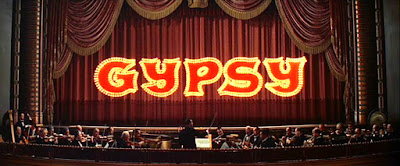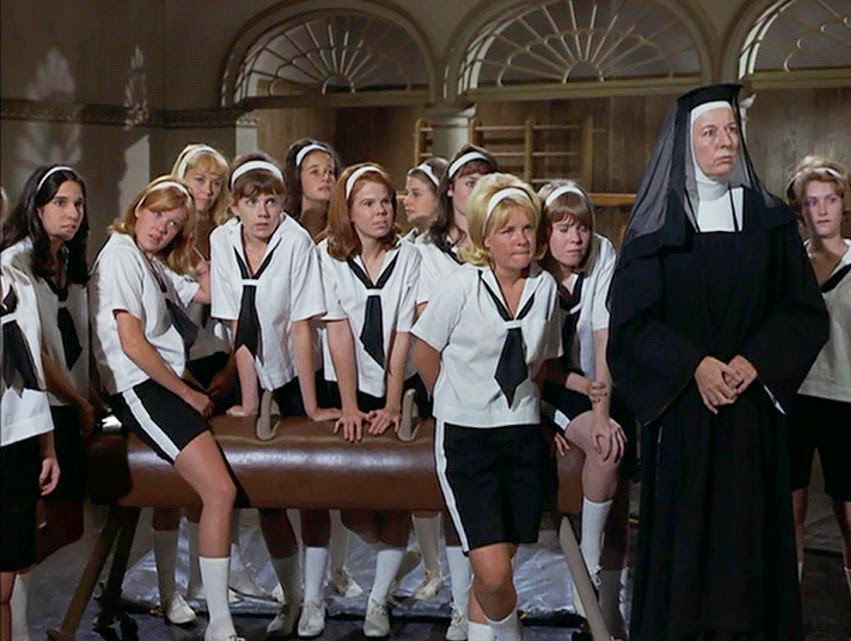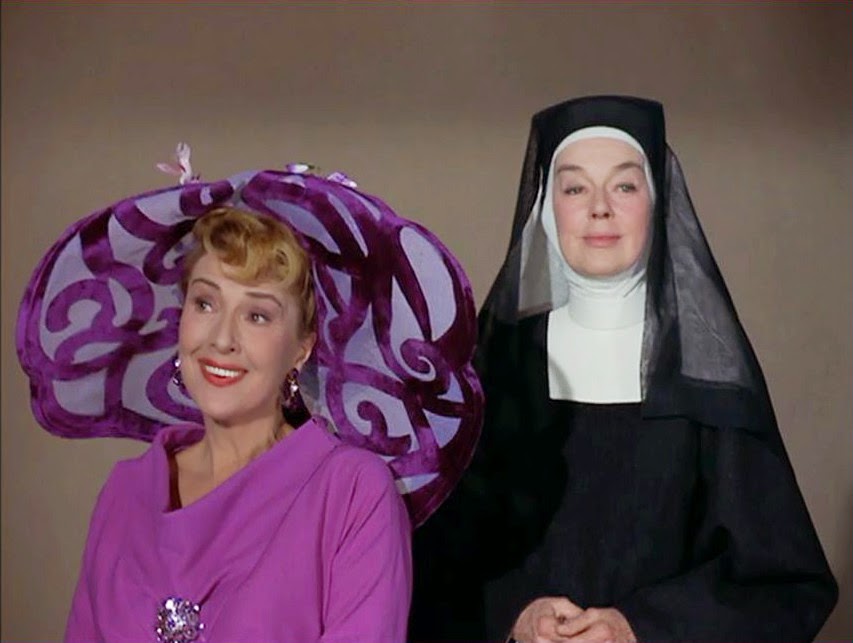 |
| Sing out, Louise! |
It’s not exactly a picnic being a movie musical fan who’s also a devotee
of live musical theater. These distinct yet inherently complementary art forms have
made such strange bedfellows over the years, I've found it necessary to run myself through a staggering array of mental acrobatics just to feel ready to commit to even the simple act of watching a film based on a favorite Broadway show.
Sometimes this means I have to ratchet down an overeager
anticipation of the sort that usually leads to disappointment (Nine, Dreamgirls). At other times this means I have to hold in check a guarded, over-protective
attitude harbored toward a beloved source material (to this day, I’m not entirely sure I
hate the film version of Grease so much because I genuinely think it’s a
lousy movie, or because its '70s-mandated disco-ification [Spandex in the 50s!] is
so at odds with the original show’s satirically nostalgic charm). Upon occasion, if the filmmaker
is particularly clever, I find I can surprise myself by being flexible and willing to surrender
to an ingenious reinterpretation and reinvention (Hair, The Wiz,
On a Clear Day You Can See Forever).
However, if I’m really committed to giving a movie adapted from a Broadway show the benefit of the doubt, I know my chief duty is to refrain from engaging in that time-honored, ultimately fruitless pastime of all self-appointed musical theater “purists”: stockpiling comparisons and evaluating motion pictures by live theater standards.
However, if I’m really committed to giving a movie adapted from a Broadway show the benefit of the doubt, I know my chief duty is to refrain from engaging in that time-honored, ultimately fruitless pastime of all self-appointed musical theater “purists”: stockpiling comparisons and evaluating motion pictures by live theater standards.
Happily, I was spared all this with Gypsy due to having discovered the movie version long
before I ever knew anything about the well-regarded Broadway show. Equally fortuitous was the fact that I fell in love
with this movie while I was still too young to know I wasn’t supposed to.
In spite of its impressive showing at the boxoffice, the
movie version of Gypsy is widely regarded
as a disappointment...if not an out-and-out failure. Citing everything from Mervyn
LeRoy’s uninspired direction to Rosalind Russell’s notoriously “manipulated”
vocals, Gypsy’s reputation as a
respectable misfire is so pervasive, few tend to credit it with one of the
things it gets absolutely right: it’s an atypically faithful movie adaptation
of a stage hit.
Because we’re a country that worships success and achievement,
people tend to react to Gypsy Rose Lee’s ultimate attainment of wealth and fame
as some kind of happy ending. As if Rose’s cutthroat determination is finally vindicated
and Louise’s lonely childhood rewarded. But I always leave the film thinking that
nobody’s won a damn thing. Louise winds up with a “dream” that was never really hers;
the anonymous adoration of “celebrity” a substitute for a heartbreakingly anonymous
childhood. And Rose, in spite of the reconciliatory tone of the fadeout, is, in
spite of all of her efforts, combating a lifetime of being abandoned, still
alone.
BONUS MATERIAL
"Mama's Talking Soft," a song composed by Styne & Sondheim for Gypsy that failed to make it into the production (it was to be a duet sung by June & Louise following "Small World"). In 1959, pop star Petula Clark recorded a cover of the song for the B-side of her single, "Where Do I Go From Here?"
 |
| Rosalind Russell as Rose Hovick |
 |
| Natalie Wood as Louise Hovick / Gypsy Rose Lee |
 |
| Karl Malden as Herbie Sommers |
Directed and choreographed by West Side Story’s Jerome
Robbins, written by Arthur Laurents (West
Side Story, Anyone Can Whistle), music
by Jule Styne (Funny Girl, Bells Are Ringing) and lyrics by Stephen
Sondheim (you name it), Gypsy, is the
highly-fictionalized 1959 Broadway musical based on the memoirs of famed
stripper Gypsy Rose Lee. On the strength of Ethel Merman’s star turn and the
show’s then-novel integration of song, narrative, and character; Gypsy was already
being heralded as a theatrical milestone by the time Warner Bros turned it into
a critically lambasted, Top-Ten boxoffice hit motion picture in 1962.
Gypsy was adapted for the screen by Leonard Spigelgass (Pepe, of all things) and directed by The Bad Seed’s Mervyn LeRoy (can you
imagine pushy Mama Rose coming across Rhoda Penmark? The Bad Seed would have had a 10-minute running time).
A backstage musical set in the waning, transitional days of
vaudeville, Gypsy is a family drama
(some would say tragedy) about Rose Hovick’s stop-at-nothing efforts to make
her daughter, blonde and talented “Baby” June, a star. There’s another daughter, of course, the shy and talent-challenged Louise, but that’s a fact the
thrice-married Rose makes the best of rather than rejoices in. As the family
and their ragtag vaudeville act tour the country, Rose takes up with and
secures the managing services of marriage-minded Herbie, a former kiddie talent
show host. Meanwhile, her daughters grow restless for another kind of life:
June, for a solo career on Broadway, Louise, for a stable home and family.
Four characters, four different dreams. But in Gypsy, only Rose’s dreams matter, which
we come to learn is Rose’s one true talent. Mama Rose has a gift for deluding herself into believing her relentless ambition is genuinely in the interest of
others. Gypsy’s humor, heart, conflict, and drama derive from the sometimes ruthless
lengths Rose is willing to go to make those dreams come true.
 |
| "Some People" |
Me, I place myself in the opposite camp. While far from what
I’d consider a classic, Gypsy is
nevertheless one of my favorite movie musicals. It’s tuneful (not a clunker in the bunch!), funny, well-acted (save for the dreadful acting of young Louise and the strenuous overplaying of the chorus boy with the Bowery Boys shtick), and one of those rare musicals with genuine dramatic heft. And as good as I think Natalie Wood is in this, the real
jewel in Gypsy’s crown is Rosalind
Russell. She’s the first Mama Rose I ever saw, and although the role has been
better sung and more showily performed, after all these years I’ve never seen anyone
come close to Russell in giving Rose Hovick the kind of depth and humanity necessary to
make me care about this somewhat monstrous creature.
Rosalind Russell IS Mama Rose to me.
WHAT I LOVE ABOUT
THIS FILM
I couldn’t have been more than
eight or nine when I saw Gypsy on TV
for the first time. My older sister was a rabid Rosalind
Russell fan, so watching Gypsy, a
musical I knew absolutely nothing about, was not a choice, but a household
edict. Viewed on the family’s living room console, Gypsy as first seen by me, was in black & white, pan and scan,
with commercial interruptions and edits for time. In fact, it wasn’t until many
years later, when Gypsy aired uncut on cable, that I even KNEW the "Little Lamb" number was a part of the film. It had been edited out of every television broadcast I'd seen.
But even
with these limitations, I thought Gypsy
was something pretty special. Being a child myself, I was enthralled in those
pre-Annie / Oliver! days, by a non-kiddie movie where kids played such an
integral role in the plot, and similarly, the whole “family” thrust of the
dramatic conflict was nicely within the scope of what I could understand.
Although I must add, being at an age where my notions of good/bad - hero/villain
were still pretty simplistic; the chilling vision of motherhood as presented
by the charismatic, likable, yet overweeningly selfish Mama Rose was really
quite a shock to the system.
I
remember loving all the musical numbers (especially “You Gotta Get a Gimmick”),
thinking Natalie Wood was really a knockout (something I dared not relay to my
sisters, lest be teased unmercifully), and just being bowled over by Rosalind
Russel’s powerhouse performance. Then, as now, she fairly eclipses everything
else about the film for me.
Over the years, as my appreciation for Gypsy grew both in terms of concept and context, the film never ceased being a favorite; even if all those repeat viewings only made me more
aware of the film’s many flaws and inadequacies.
When critics hail Gypsy
for its seamless integration of song, story, and character, the downbeat themes
masked by its cheery vaudeville visage, and the emotional complexity of its
lead character, you’ll get no argument from me.
If I have any complaints, it’s that the film’s innocuously cheery,
prototypically '60s roadshow approach to the material seriously undercuts what’s
so special about Gypsy as a musical property. There’s something disturbingly Eugene O’Neill-ish lurking beneath
all that Hovick family dysfunction that the movie only touches upon.
 |
| "If Momma Was Married" |
Russell and Wood are both effective at accessing some of the
darker corners of their characters (as much as the screenplay allows), but it
would be years before Hollywood felt comfortable reshaping the movie musical—traditionally a family-oriented genre—to accommodate more serious themes (Sweeney Todd, Cabaret, All That Jazz, Into the Woods).
PERFORMANCES
Movie musicals were having a hard go
of it in the 1960s, and studios hedged their bets wherever they could. In Gypsy’s case, this meant turning a
groundbreakingly complex, 4-character dysfunctional family musical drama into a
splashy, $4 million, widescreen crowd-pleaser. It also meant ignoring the
near-unanimous praise heaped on Ethel Merman’s head for what many considered to
be her career-defining role and performance (vocally immortalized on the
Original Broadway Cast album that seemed to be in every home, by law, when I
was growing up), and going with a more skilled screen actress with marquee recognition. An actress
whose biggest drawback was that her voice wasn’t up to the demands of the
written-specifically-with-Merman-in-mind musical score.
Bankable Rosalind Russell, adding a touch of Lavinia Mannon
steeliness (Mourning Becomes Electra)
to her Auntie Mame steamroller
ebullience, controversially stepped into the made-to-order shoes of Ethel
Merman in the iconic role of Mama Rose: stage mother to end all stage mothers.
 |
| Rosalind Russell's vocals were largely handled by Lisa Kirk A 2003 CD release of the Gypsy soundtrack included a few outtake samples of Russell singing unassisted. Hoo boy! |
After having seen Ethel Merman in the
movies Call Me Madam and There’s No Business Like Show Business,
it’s hard for me not to appreciate the soundness of any decision designed to
keep her off the screen (although I have to concede she’s pleasant and very
un-Ethel Merman like in those early Eddie Cantor musicals). However, the
by-product of Merman being passed over has been the fostering of an idealized “What if?” scenario regarding
Merman recreating her greatest stage success onscreen, A fantasy scenario that has followed
Rosalind Russell’s Gypsy around like
one of Madame Rose’s trunks.
But speculating about what was
missed in not granting Merman the opportunity to play onscreen the role she originated onstage, fails to take into account what a significant
contribution an actress of Russell’s caliber (equally deft at playing comedy or drama) brings to a movie this stagy and set-bound.
Natalie Wood, fresh off of doing whatever she thought she was
doing with that Puerto Rican accent in West Side Story (1961), was cast as late-blooming ecdysiast, Gypsy Rose Lee.
Natalie Wood has always held a lot of appeal for me, and her
genuinely sweet persona is used to great effect during the film’s first half,
just as her remarkable figure and stunning beauty provide a perfect contrast/payoff
in the second. I’m not sure how she does it (star quality alone?), but her
Louise looms larger in the film than it does in any stage production of Gypsy I’ve ever seen. That Wood
naturally has the ability to make you care about her is one of the reasons I
think her rather underwritten role carries so much poignancy.
Natalie Wood shines brightest in her quiet scenes. Consequently, her big, dressing room outburst moment is, for me, her weakest. But in delivering a few well-placed
snarky lines to her meddlesome mom, Wood’s transformation from mouse to sardonic
cat is a delight.
THE STUFF OF FANTASY
Natalie Wood sings "Little Lamb"
Maybe it’s because I was deprived of it for so many years.
Maybe it’s because Natalie Wood’s vocals remind me of Audrey Hepburn singing “Moon
River” in Breakfast at Tiffany’s.
Maybe it’s because all my taste is in my mouth. Whatever the reason, “Little
Lamb,” a song so maudlin it would make Mother Teresa roll her eyes, is my favorite song in the film.
I love that it is the single, solitary moment afforded to the pushed-to-the-sidelines Louise, and the first time we get to hear about what someone else feels besides Rose. This external internal monologue captures so perfectly a child’s loneliness (associating sadness with what should be a happy occasion) with the single lyric: “Little cat. Little cat. Oh, why do you look so blue? Did somebody paint you like that, or is it your birthday, too?”
I love that it is the single, solitary moment afforded to the pushed-to-the-sidelines Louise, and the first time we get to hear about what someone else feels besides Rose. This external internal monologue captures so perfectly a child’s loneliness (associating sadness with what should be a happy occasion) with the single lyric: “Little cat. Little cat. Oh, why do you look so blue? Did somebody paint you like that, or is it your birthday, too?”
That just knocks me the hell out. Reduced to waterworks each
and every time.
Most musicals have draggy second acts, but Act II of Gypsy has two fabulous numbers: The show-stopping “You Gotta Get a Gimmick” and that masterfully-constructed musical nervous breakdown, “Rose’s Turn.”
Most musicals have draggy second acts, but Act II of Gypsy has two fabulous numbers: The show-stopping “You Gotta Get a Gimmick” and that masterfully-constructed musical nervous breakdown, “Rose’s Turn.”
 |
| "You Gotta Get a Gimmick" Roxanne Arlen as Electra, Betty Bruce as Tessie Tura, and Faith Dane as Mazeppa |
The one number that's perfectly fine but that I could do without is "All I Need Is The Girl". But this likely has to do with the song being done to death on TV variety shows long before I ever saw Gypsy. But the rousing "Mr. Goldstone We Love You" is a number I could watch a hundred times.
 |
| "Mr. Goldstone, I Love You" That's character actor Ben Lessy as Mr. Goldstone - dubbed Mervyn Goldstone in inside-joke in honor of director Mervyn LeRoy |
It's a shame the cute "Together Wherever We Go" number was deleted from the film before its release. Karl Malden had all of his singing bits (he sang briefly in "You'll Never Get Away From Me") left on the cutting room floor. Happily, 16mm prints of both numbers appear as part of the extras on the Gypsy DVD.
 |
| "Together Wherever We Go" |
THE STUFF OF DREAMS
One of the things I like most about Gypsy and why I think it’s so deserving of its status as one of the
greatest American musicals is that one could talk to fans and detractors of the
show all day and never hear the exact same take on Mama Rose. In spite of her dominating
presence in every scene of the musical, hers is a character influenced as much
by a particular actress’s interpretation as by the audience’s response to her behavior.
 |
| "Don't you DARE answer that phone when I'm yelling at you!" That's Jean Willes quaking in her boots as Mr. Grantzinger's secretary |
I’m one of those who sees Mama Rose as (to quote author Lewis
Carroll on the topic of unicorns) a “fascinating monster.” She’s pitiable and perhaps sympathetic in
that she’s a woman clearly driven by frustration (what outlets did a woman with
her brains, drive, and ambition have in the 1920s?), selfish desire, and her own
childhood abandonment. But her treatment of her daughters—all in the name of
love—qualifies her as a largely detestable character.
And as a look at some of my favorite films with strong
female characters will reveal (Blue Jasmine, Queen Bee, Mommie Dearest, Angel Face, The Day of the Locust, Darling, Hedda), I have a real affinity for fabulous monsters.
Rosalind Russell, in not shying away from Rose’s unpleasant
side, gives a portrait of a woman of contradiction. Contradictions so keenly felt during the “Rose’s
Turn” number that by the time mother and daughter take a hesitant stab at
reconciliation at the finale, the scene resonates with melancholy. Melancholy because (if
you’re as old as me and your parents are no longer around) it seems to be the inevitable legacy of the adult child
to one day realize that one's parents, even at their worst and most flawed, were never more or less
than simply human.
 |
| The real-life Gypsy Rose Lee appeared onscreen opposite her motion picture mother, Rosalind Russell in the 1966 comedy, The Trouble With Angels |
"Let Me Entertain You"
Copyright © Ken Anderson 2009 - 2015














































.jpg)


.JPG)





